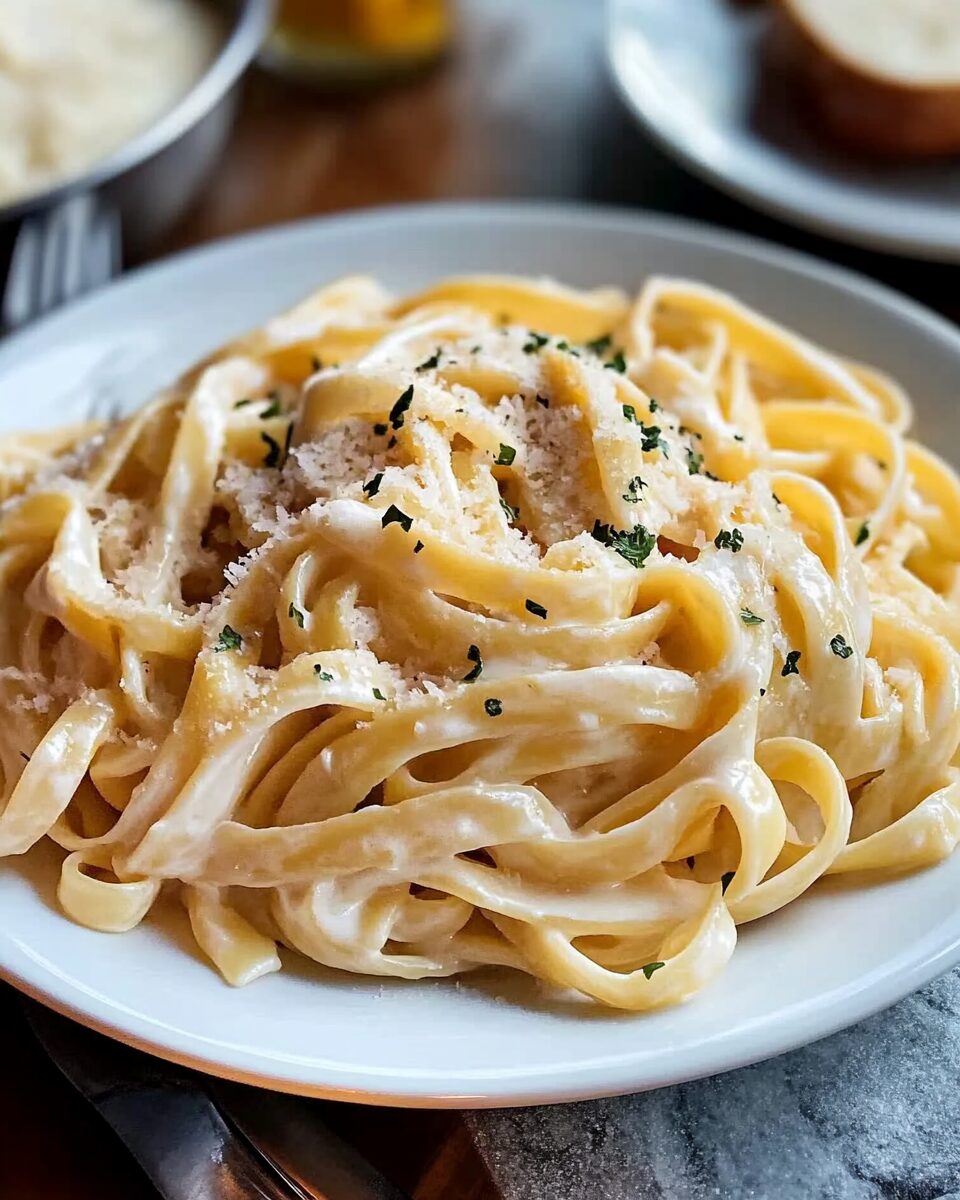The silky creaminess of this Fettuccine Alfredo is everything you crave in a cozy pasta dish. A whisper of shallots, luxurious cream, and a generous snowfall of freshly grated Parmigiano Reggiano create a sauce so luscious, it clings to every ribbon of pasta like a warm hug.
Unlike heavy versions that drown in cream, this recipe highlights a chef’s secret: emulsifying the sauce with pasta water. The result? A glossy, rich, restaurant-quality dish that feels decadent but is surprisingly light on calories. Perfect for weeknights when you want something satisfying without overindulgence.
Full Recipe:
-
8 oz (250g) dried fettuccine
-
3 tbsp unsalted butter
-
1 small shallot, very finely minced
-
1/2 cup heavy cream
-
3/4 cup freshly grated Parmigiano Reggiano
-
1/4 tsp salt
-
Freshly ground black pepper
-
Garnish: extra Parmigiano Reggiano and fresh parsley (optional)
Directions:
-
Bring a large pot of salted water to a boil. Add fettuccine and cook until al dente, about 1 minute less than package instructions.
-
While pasta cooks, melt butter in a deep fry pan over medium-high heat.
-
Add minced shallot and sauté for about 2 minutes until tender.
-
Pour in cream and bring to a boil. Reduce heat to medium-low and simmer for 3 minutes.
-
Remove pan from heat and stir in the Parmigiano Reggiano, salt, and black pepper until sauce is smooth.
-
Reserve 1/4 cup pasta water and an extra mug-full just in case. Drain pasta.
-
Transfer cooked pasta and reserved 1/4 cup pasta water to the pan with sauce.
-
Return to medium-high heat and gently toss pasta for about 1 minute until sauce emulsifies and clings to every strand.
-
Serve immediately with extra cheese and parsley, if using.
Prep Time: 5 minutes | Cooking Time: 15 minutes | Total Time: 20 minutes
Kcal: 426 kcal | Servings: 3 servings
The Story Behind Fettuccine Alfredo
Fettuccine Alfredo is more than just a creamy pasta dish; it’s a culinary classic rooted in Italian tradition, yet transformed by American indulgence. Its origin traces back to early 20th-century Rome, where Alfredo di Lelio first created the dish for his wife, who had lost her appetite after childbirth. His original version was a simple combination of fettuccine, butter, and Parmigiano Reggiano — no cream at all.
However, as the recipe made its way to the United States, it evolved into what we now know as the iconic creamy Alfredo — a rich and silky sauce that embraces every strand of pasta. It became wildly popular in American-Italian cuisine, often served in restaurants as a go-to comfort food. Over the decades, the dish has been modified in countless ways, from chicken Alfredo to shrimp Alfredo and even low-fat versions.
Why This Version of Alfredo Stands Out
Unlike many overly rich recipes that rely on heavy amounts of cream, this version of Fettuccine Alfredo strikes a delicate balance. It uses just enough cream to deliver richness without being cloying. What truly elevates it is the emulsification technique — a classic Italian method where pasta water is used to bind the sauce to the noodles, creating that signature glossy, clingy texture without overwhelming the dish with fat.
This isn’t just about indulgence; it’s about intelligent cooking. The sauce is crafted to lightly coat the pasta rather than drown it, resulting in a dish that feels luxurious but not excessive. That’s the real art of Alfredo — restraint paired with technique.
Understanding Emulsification: The Key to Glossy Sauce
A pivotal element of this dish is the step where pasta water and sauce come together in the pan. This process, known as emulsification, is the magic that turns a simple cream and cheese mixture into a restaurant-quality coating. Pasta water, rich in starch, helps bond the fat from the butter and cream with the cheese and noodles.
When done correctly, you’ll notice a silky sauce that glistens and adheres beautifully to each strand of fettuccine. This step doesn’t just improve texture — it enhances flavor and makes the dish feel more cohesive and luxurious.
Choosing the Right Cheese: Parmigiano Reggiano vs Parmesan
One of the secrets behind a truly memorable Alfredo lies in the cheese. While regular parmesan works in a pinch, Parmigiano Reggiano offers a nuttier, deeper flavor that’s slightly sweet and more complex. It melts smoother, thanks to its fine texture when freshly grated, and is worth the splurge, especially in a minimalist recipe where cheese is a starring ingredient.
Avoid pre-grated cheese or powdered alternatives — they tend to be grainy and may not melt well, resulting in a broken or clumpy sauce. Freshly and finely grating the cheese is non-negotiable for the silkiest results.
When to Serve Fettuccine Alfredo
This dish is remarkably versatile. It’s perfect for a cozy night in when you’re craving something warm and comforting. It also makes for a great date night meal — it’s indulgent and satisfying without being too complicated. And thanks to its rich flavor, it’s elegant enough to serve at dinner parties with minimal effort.
Pair it with a light side like a crisp green salad or roasted vegetables to add freshness and balance. Garlic bread, of course, is always a welcome addition.
Tips for the Perfect Alfredo Pasta
-
Cook pasta al dente: Since the pasta will continue cooking slightly in the sauce, undercooking it by about a minute ensures it doesn’t get mushy.
-
Reserve extra pasta water: You’ll need at least 1/4 cup, but it’s wise to scoop out more in case you need to adjust the sauce’s consistency.
-
Use a deep pan: Tossing the pasta properly requires space. A large, deep skillet or sauté pan allows for better emulsification and even coating.
-
Don’t overheat the sauce after adding cheese: High heat can break the cheese emulsion. Remove the pan from direct heat before stirring in the cheese.
Variations You Can Try
Although the original is divine on its own, Fettuccine Alfredo is highly adaptable. Here are some variations to suit different tastes and dietary preferences:
-
Chicken Alfredo: Add grilled or sautéed chicken breast for a protein boost.
-
Shrimp Alfredo: A seafood twist that brings elegance and a touch of sweetness.
-
Mushroom Alfredo: Earthy and satisfying, perfect for vegetarians.
-
Broccoli Alfredo: Adds a pop of color and a fresh, slightly bitter contrast to the richness.
-
Gluten-Free Version: Use gluten-free pasta and double-check your cheese for any additives.
For a lighter version, you can experiment with half-and-half instead of heavy cream, though the sauce may not be as rich. A touch of nutmeg can add unexpected depth, especially in winter.
Pairing Ideas: What to Drink With Alfredo
Because of its richness, Fettuccine Alfredo pairs best with something that can cut through the creaminess. A crisp white wine such as Pinot Grigio or Sauvignon Blanc works beautifully. If you’re more of a red wine drinker, go for a light-bodied option like Pinot Noir.
Sparkling water with lemon, or even a dry cider, can also be refreshing and help balance the meal.
What Makes It a Restaurant-Quality Dish at Home
What elevates this dish beyond a typical home-cooked meal is the professional technique applied in a straightforward way. You don’t need exotic ingredients or hours in the kitchen. By following core Italian methods — high-quality ingredients, emulsification, proper timing — you can create a dish that feels like it came out of a trattoria in Rome.
Restaurant versions often appear richer because they use tons of cream or butter, but this recipe smartly relies on process, not excess. That means you can indulge without the heaviness or guilt that usually follows.
Advertisement
Common Mistakes to Avoid
-
Using too much cream: More doesn’t mean better. Too much cream makes the sauce heavy and masks the cheese.
-
Skipping the emulsification step: This is what brings the dish together. Without it, your sauce may be watery or separate.
-
Overcooking the pasta: Especially when finishing in the sauce, slightly underdone pasta is key to achieving the right texture.
-
Using low-quality cheese: Don’t skimp on the cheese. It’s one of the main flavor components, so choose wisely.
Conclusion: Why You’ll Keep Coming Back to This Dish
Fettuccine Alfredo is a timeless comfort food that never fails to please. Its luxurious creaminess, nutty cheese, and silky texture make it a go-to dish for any occasion — from weeknight meals to special dinners. This recipe honors the dish’s heritage while offering a modern, balanced version that’s simple to master.
By using proper technique and quality ingredients, you’ll unlock a deeper appreciation for what may seem like a humble plate of pasta. With just a few pantry staples and a little finesse, you can create an extraordinary meal that tastes like it came straight out of an Italian kitchen.
Whether you’re new to cooking or a seasoned home chef, this version of Fettuccine Alfredo is sure to become a beloved favorite in your repertoire.






